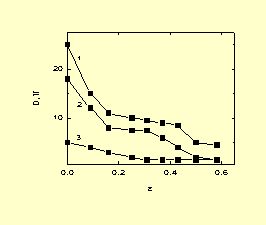

X-RAY STUDY OF THE ORDER - DISORDER TRANSFORMATION BY THE PLASTIC DEFORMATION
Starenchenko S.V., Kozlov E.V., Starenchenko V.A.
Tomsk State University of Architecture and
Building, Solyanaya sq. 2, Tomsk, 634003, RUSSIA
Keywords: alloys, disordering, X-ray diffraction, order - disorder transformation, plastic deformation.
The thermal order-disorder transformation has been the subject of numerous experimental and theoretical investigations, most of which has involved measurements of the transition temperatures, the structure types, the change with temperature of the long range order parameters and other properties. Except the temperature influence there are many other of factors responsible for phase transition, one of which is a plastic deformation.
The plastic deformation is capable to give rise to the order-disorder transformation. Essentially this transformation has not been studied although its possibility has been repeatedly mentioned.
The experimental facts concerning the influence of the plastic deformation on the long range order in the well-ordered alloys with L12 and L12(M) superstructure have been reported in this work.
The alloys Au3Cu, Ni3Fe, Cu3Pd, Au4Zn nonstoichiometric Cu3Pt, were chosen for present investigation (Au3Cu Cu3Pd, Au4Zn and Cu3Pt were in polycrystalline state and Ni3Fe was a single crystal). The samples were deformed by cold-rolling and then studied by the X-rays diffraction methods.


Fig. 1. Variations of 1) the long-range order parameter - 2) the change rate of the long-range order parameter with strain - /; 3) the lattice parameter - à in an ordered alloy Au3Cu with amount of strain by rolling.
Fig. 2. Variation of antiphases domains sizes in Au3Cu with amount of strain by rolling (1 - large-, 2 - medium-, 3 - small-sized).
The results of studing an alloy Au3Cu are presented on the fig. 1 and fig. 2.
A comparison between strain and temperature dependencies of the long-range order parameter (h(e) and h(T)) shows that we can safely assume that the areas of the material possessing FCC the structure (À1) make their appearance during the process deformation. That is the order - disorder phase transformation L12 À1 takes place and it occurs heterogeneously. The disordered areas emerge after a permanent deformation of a few percents and their amount increases in the process deformation. At rather large strain the alloys become disordered. The lowering of the long-range degree of an alloy is accompanied by an inhomogeneous decreasing the antiphase domains sizes (fig.2), in parallel with the large domains presence small-sized domains are found out and their proportions grow with the strain increasing. The observable facts give proof to the heterogeneity of the order - disorder transformation, connected with the strain localization.
The influence of the strain on the structural state of the alloys is carried out under the following scheme:
L12 L12 + A1 A1
Such transformation, can be connected with a number of plastic deformation mechanisms. These mechanisms are divided on two groups.
The mechanisms concern to the first group change an atomic long-range order in the slip planes owing to generation antiphase boundaries (APB) by mobile dislocations.
The APB generation takes place at intersection of mobile dislocations with thermal APB and this intersection will make to antiphases domains structure changes; at APB tubes creation stemming from intersection superdislocations possessed by different slip systems; at superdislocations multiplication, which is the cause of the dislocation density increase and accordingly increase of APB total areas, connecting single dislocations in a superdislocation; the influence of local internal stresses on dissociated superdislocations splitting can be also the cause of APB total area increase.
Other group of mechanisms is responsible for the long-range order decrease in the volume of deformed crystal. These mechanisms are primarily connected with the point defects generation in the course of plastic deformation. The plastic deformation creating elastic distortions of a crystalline lattice is capable to change the order - disorder transition temperature, and the resulting inhomogeneous stresses can be a cause of the solid solution segregation. It is also impossible to ignore such factor, as local heating of a material in the slip band.
It seems likely that the long range order decrease in the
ordered materials caused by the joint action of the mentioned
above mechanisms.